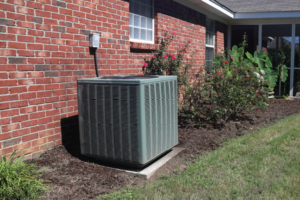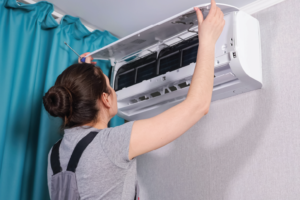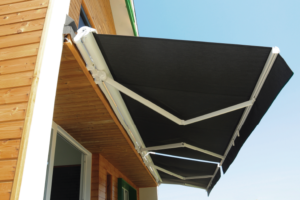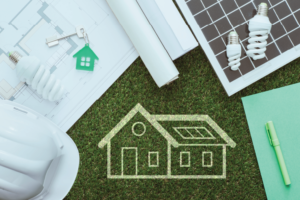How to Lower Your Energy Costs this Summer
As we celebrate Earth Month throughout April, you may have noticed warming temperatures as spring starts to give way to summer. Rising temperatures can sometimes mean rising energy bills, but there are plenty of strategies to help you save energy and keep costs down during the spring and summer. So, the North Carolina Clean Energy Technology Center (NCCETC) at NC State University has gathered a few resources and tips to help you stay cool and conserve energy while the weather is warm.
Save Money and Energy Starting Today
“There are options available for homeowners to reduce household energy consumption and save money at the same time,” said Art Samberg, Program Director for the Clean Power & Industrial Efficiency program at NCCETC. With the coming summertime heat waves that we all experience here in North Carolina, Samberg noted that now is the time to consider taking action to keep your bills as low as possible throughout the remainder of spring and into the summer.
 U.S. homeowners and renters can find information on energy efficiency and renewable energy from Energy Saver – the U.S. Department of Energy’s (DOE) consumer resource on saving energy and using renewable energy technologies at home. Energy Saver is managed by DOE’s Office of Energy Efficiency and Renewable Energy.
U.S. homeowners and renters can find information on energy efficiency and renewable energy from Energy Saver – the U.S. Department of Energy’s (DOE) consumer resource on saving energy and using renewable energy technologies at home. Energy Saver is managed by DOE’s Office of Energy Efficiency and Renewable Energy.
You can download the Energy Saver Guide: Tips on Saving Money and Energy at Home for an overview of improvements that will contribute to your energy bottom line and help make our planet healthier and cleaner. The suggestions in this guide and on the EnergySaver.gov website can help you reduce energy consumption, save money, and improve the comfort of your home.
 COOLING YOUR HOME EFFICIENTLY
COOLING YOUR HOME EFFICIENTLY
Air conditioning and space heating together are the largest energy users in your home, typically making up about 32% of your energy use, according to the DOE. No matter what kind of heating and cooling system you use in your home, proper use and maintenance and, in some cases, upgrading your equipment, can lower the cost of keeping your home comfortable on those hot and humid days that will be here soon.
 The DOE states that the most important maintenance task to complete to ensure the efficiency of your air conditioner is to clean or change the system’s filters every one to two months (depends upon the frequency of use as well as household environmental factors). A dirty or clogged filter reduces the amount of airflow and significantly reduces a system’s efficiency, making your HVAC system work harder and use more energy. The DOE notes that replacing a dirty, clogged filter with a new one can lower your air conditioner’s energy consumption up to 15%. Check out the Maintaining Your Air Conditioner guide on Energy Saver to learn more about regular maintenance needed to keep your unit functioning effectively and efficiently throughout its years of service.
The DOE states that the most important maintenance task to complete to ensure the efficiency of your air conditioner is to clean or change the system’s filters every one to two months (depends upon the frequency of use as well as household environmental factors). A dirty or clogged filter reduces the amount of airflow and significantly reduces a system’s efficiency, making your HVAC system work harder and use more energy. The DOE notes that replacing a dirty, clogged filter with a new one can lower your air conditioner’s energy consumption up to 15%. Check out the Maintaining Your Air Conditioner guide on Energy Saver to learn more about regular maintenance needed to keep your unit functioning effectively and efficiently throughout its years of service.
During the summer, set your thermostat as high as is comfortable when you are home and awake, and raise the temperature higher when you are sleeping or away from home. The smaller the difference in temperature between inside and outside, the lower your energy usage and overall bill will be.
Keep blinds, drapes, and curtains closed during the day throughout the summer to block heat from the sun from entering the home. There are window coverings and attachments that can be installed to prevent heat gain through windows during the day. Window attachments are products which can be attached to a window either internally or externally to improve energy performance, increase comfort, reduce glare, provide privacy and enhance the appearance and value of your home.
 In cooling seasons, about 76% of sunlight that falls on standard double-pane windows enters the home as heat, according to the DOE. Window coverings can reduce the amount of the sun’s energy that is transferred through windows to your home, thus helping to keep your home more comfortable using less energy and lowering energy bills.
In cooling seasons, about 76% of sunlight that falls on standard double-pane windows enters the home as heat, according to the DOE. Window coverings can reduce the amount of the sun’s energy that is transferred through windows to your home, thus helping to keep your home more comfortable using less energy and lowering energy bills.
Using ceiling fans in occupied rooms can also supplement your air conditioning, but make sure to turn them off when you leave the room. Turning off lights in unoccupied rooms is another way to save energy and avoid added heat emitted from light sources.
Home Energy Use Assessments
Obtaining a home energy audit, or home energy assessment, can help you understand the complete picture of your home’s energy use, potential home energy inefficiencies, and which problem areas and fixes you need to prioritize to save energy and improve the comfort of your home.
 DO-IT-YOURSELF HOME ENERGY ASSESSMENT
DO-IT-YOURSELF HOME ENERGY ASSESSMENT
A “do-it-yourself” home energy assessment will not be as comprehensive as a professional home energy assessment, but it can help you start identifying some of the easier problem areas to address. Always be mindful of your safety when conducting home energy audits, especially in tight spaces and when inspecting electrical equipment. It is always best to follow manufacturer safety guidelines.
The DOE’s Energy Saver lists these areas to inspect during a self-assessment to help you pinpoint problem areas and prioritize your energy efficiency upgrades:
- Locate and seal air leaks
- Ventilation – self-inspection is fine, but changes to ventilation systems and/or changing the amount of ventilation should be performed by an energy professional
- Check insulation levels
- Inspect Heating and Cooling Equipment
- Lighting
- Appliances and Electronics
PROFESSIONAL HOME ENERGY AUDITS
Professional energy assessments can give you a roadmap to lowering energy costs and improving the comfort of your home. An industry-certified professional will examine your residence by doing a room-by-room walkthrough to gather information and produce a report outlining characterizations of your home and its energy consumption along with actions you can take to reduce your home’s energy use while maintaining or increasing comfort of the living space. Learn more about professional home energy assessments.
Financing, Incentives, and Assistance
Duke Energy customers can take advantage of a free professional home energy assessment through the Home Energy House Call program offered by the utility. If you own your single-family home for at least four months, and have an electric water heater, electric heat or central air, you could be eligible for this service and receive a free in-house energy assessment valued at $180.
The Home Energy House Call includes a free home energy assessment with an energy specialist, a free personalized report to save energy and money and a free energy savings kit with LED lightbulbs, weather stripping, showerhead and more. During the assessment, the energy specialist will conduct a thorough in-home analysis of your total home energy usage, check your home for air leaks, examine your insulation levels, and review your appliances and heating/cooling system.
RESIDENTIAL TIME-OF-USE RATES
The time of day when you are using energy can also determine how much you will be charged for energy consumption. Typically, utilities charge a higher rate during “peak” hours when demand for electricity is the highest and a lower rate during times when both the cost of generating electricity and demand for electricity are low.
Time-Of-Use (TOU) rates vary by season, day of the week, holidays and across multiple determined hours throughout a given day. For example, the Fayetteville Public Works Commission (Fayetteville PWC) identifies its peak periods as 3-7 p.m. for summer months (April through October) and 6-10 a.m. for winter months (November through March). Peak periods are defined for weekdays only.
NCCETC is currently collaborating with Fayetteville PWC to host and manage an online rate calculator to assist residential customers in determining their potential savings from shifting their high-demand household appliance usage to off-peak hours. As part of this partnership, NCCETC worked with PWC to create the online calculator dashboard.
Fayetteville PWC’s online energy use calculators can help you estimate how much electricity an appliance is using and how much the electricity costs you to determine whether adjusting daily routines or investing in a more energy-efficient appliance could help you lower your electricity bill. You can calculate your savings with TOU rates, ENERGYSTAR appliances like your dishwasher or washing and drying machine, and LED lighting.
The Fayetteville PWC Residential Time-Of-Use Rate Calculator enables customers to see the average cost they pay per kilowatt/hour (kWh) based on their on- and off-peak use to quantify the difference off-peak energy consumption makes and to help determine the best rate plans to meet their specific needs. Customers can save money by adjusting their daily weekday routine and shifting more of their electrical use to off-peak hours when off-peak TOU rates are 30% less than on-peak rates, according to Fayetteville PWC.
Many utilities offer programs encouraging customers to use electricity during off-peak hours to help reduce peak power demands, use resources more efficiently, reduce operating costs, and help their customers save money. The programs pass on the savings to you, the customer, through rebates or reduced electricity rates.
 Timed-based rates for electricity usage are particularly attractive for owners of plug-in and all-electric vehicles who charge overnight with a charger installed at their home. While the EV industry and its effects on the grid are still rather new and can vary from state to state, utilities have started exploring different approaches to influence customer charging behavior, commonly referred to as managed charging. Learn more about recent developments in managed charging.
Timed-based rates for electricity usage are particularly attractive for owners of plug-in and all-electric vehicles who charge overnight with a charger installed at their home. While the EV industry and its effects on the grid are still rather new and can vary from state to state, utilities have started exploring different approaches to influence customer charging behavior, commonly referred to as managed charging. Learn more about recent developments in managed charging.
INCENTIVES AND REBATES
When searching for incentives, consider federal, state, local, utility, and retail incentives to maximize cost-effectiveness. You can also reach out to your utility directly to find out if they offer any rebates.
One example of a utility-implemented rebate is the Residential Energy Efficiency Rebate program available to Duke Energy Progress customers. This rebate program offers financial incentives for eligible efficiency technologies such as water heaters, heat pumps, air conditioners, duct/air sealing, insulation, pool pumps and geothermal pumps for residential customers.
Visit the Database of State Incentives for Renewables & Efficiency (DSIRE) to learn more about federal, state and utility policies and incentives to assist with paying for energy-saving home improvements or purchases. Maintained and operated by the NCCETC, DSIRE is the most comprehensive source of information on clean energy related policies and incentives in the United States with summaries of more than 2,600 incentives and policies.
“The Many Incentives for Homeowners in the Inflation Reduction Act” provides an overview on the provisions of the 2022 Inflation Reduction Act (IRA) that target the residential sector. The IRA appropriated money to establish rebate programs at the state-level for residential energy efficiency improvements and distributed $4.3 billion to state energy offices through 2031 to implement Home Energy Performance-Based Whole-House Rebate (HOMES) programs. These programs will target those carrying out energy efficiency upgrades of single-family or multi-family homes with incentives based on the modeled energy savings of the retrofits.
The Residential Energy Efficiency Tax Credit, created by the Energy Policy Act of 2005, gives homeowners a tax credit for certain energy efficient purchases. The IRA extended this credit through December 31, 2032 and increased its value for purchases made after December 31, 2022.
The Residential Renewable Energy Tax Credit was also created by the Energy Policy Act of 2005, and provides a tax credit for renewable energy equipment purchased by homeowners. Previous legislation had established a phaseout of the credit, decreasing to 22% in 2023 and expiring completely in 2024. The Inflation Reduction Act delayed the phaseout of the credit and extended the expiration date.
With these resources, you have the power to save money and energy in your own home. By taking steps to improve energy efficiency in your home and conserve energy usage, you can reduce the nation’s demand for electricity and resources needed to generate power while reducing your electric utility bills and potentially improving the comfort of your home. If you’re interested in pursuing a renewable energy option like solar power, read our tips for financing a successful and sustainable residential solar photovoltaic system.